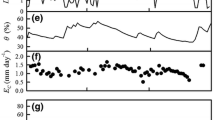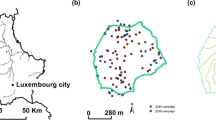Abstract
Rates of water uptake by individual trees in a native Australian forest were measured on the Liverpool Plains, New South Wales, Australia, using sapflow sensors. These rates were up-scaled to stand transpiration rate (expressed per unit ground area) using sapwood area as the scalar, and these estimates were compared with modelled stand transpiration. A modified Jarvis-Stewart modelling approach (Jarvis 1976), previously used to calculate canopy conductance, was used to calculate stand transpiration rate. Three environmental variables, namely solar radiation, vapour pressure deficit and soil moisture content, plus leaf area index, were used to calculate stand transpiration, using measured rates of tree water use to parameterise the model. Functional forms for the model were derived by use of a weighted non-linear least squares fitting procedure. The model was able to give comparable estimates of stand transpiration to those derived from a second set of sapflow measurements. It is suggested that short-term, intensive field campaigns where sapflow, weather and soil water content variables are measured could be used to estimate annual patterns of stand transpiration using daily variation in these three environmental variables. Such a methodology will find application in the forestry, mining and water resource management industries where long-term intensive data sets are frequently unavailable.





Similar content being viewed by others
References
Banks R (1998) Soil landscapes of the Blackville 1:1000 000 sheet. Department of Land and Water Conservation, Gunnedah
David TS, Ferreira MI, David JS, Pereira JS (1997) Transpiration from a mature Eucalyptus globulus plantation in Portugal during a spring–summer period of progressively higher water deficit. Oecologia 110:153–159
Dolman AJ, Gash JHC, Roberts J, JSW (1991) Stomatal and surface conductance of tropical rainforest. Agric For Meteorol 54:303–313
Eamus D, Shanahan S (2002) A rate equation model of stomatal responses to vapour pressure deficit and drought. BMC Ecology 2:1–14
Eamus D, Hutley, LB, O’Grady AP (2001) Daily and seasonal patterns of carbon and water fluxes above a north Australian savanna. Tree Physiol 21:977–988
Eamus D, Hatton T, Cook P, Colvin C (2006) Ecohydrology: vegetation function, water and resource management. CSIRO, Melbounre, pp 348
Ewers BE, Oren R (2000) Analyses of assumptions and errors in the calculation of stomatal conductance from sap flux measurements. Tree Physiol 20:579–589
Ewers BE, Mackay DS, Samanta S (2007) Interannual consistency in canopy stomatal conductance control of leaf water potential across seven species. Tree Physiol 27:11–24
Gash JHC, Shuttleworth WJ, Lloyd CR, Andre JC, Goutorbe JP, Gelpe J (1989) Micrometeorological measurements in Les Landes forest during hapex-mobilhy. Agric For Meteorol 46:131–147
Granier A, Biron P, Leoine D (2000) Water balance, transpiration and canopy conductance in two beech stands. Agric For Meteorol 100:291–308
Harris PP, Huntingford C, Coxb PM, Gasha JHC, Malhi Y (2004) Effect of soil moisture on canopy conductance of Amazonian rainforest. Agric For Meteorol 122:215–227
Howe P, Cook PG, O’Grady AP, Hillier J (2005) Pioneer Valley groundwater consultancy 3: analysis of groundwater dependent ecosystem requirements. In Report for the Queensland of Natural Resources and Mining. Resource and Environmental Management, South Australia, 117 pp.
Jarvis PG (1976) The interpretation of the variations in leaf water potential and stomatal conductance found in canopies in the field. Phil Trans R Soc Lond B 273:593–610
Kelliher FM, Leuning R, Schulze ED (1993) Evaporation and canopy characteristics of coniferous forests and grasslands. Oecologia 95:153–163
Komatsu H, Kang Y, Kume T, Yoshifuji N, Hotta N (2006a) Transpiration from a Cryptomeria japonica plantation, part 1: aerodynamic control of transpiration. Hydrol Process 20:1309–1320
Komatsu H, Kang Y, Kume T, Yoshifuji N, Hotta N (2006b) Transpiration from a Cryptomeria japonica plantation, part 2: responses of canopy conductance to meteorological factors. Hydrol Process 20:1321–1334
Kosugi Y, Takanashi S, Tanaka H, Ohkubo S, Tani M, Yano M, Katayama T (2007) Evaportranspiration over a Japanese cypress forest. I. Eddy covariance fluxes and surface conductance characteristics for 3 years. J Hydrol 337:269–283
Lagergren F, Lindroth A (2002a) Transpiration response to soil moisture in pine and spruce trees in Sweden. Agric For Meteorol 112:67–85
Lagergren F, Lindroth A (2002b) Transpiration response to soil moisture in pine and spruce trees in Sweden. Agric and For Meteorol 112:229–243
Lu P, Yunusa IAM, Walker RR, Muller WJ (2003) Regulation of canopy conductance and transpiration and their modelling in irrigated grapevines. Funct Pl Biol 30:689–698
Lundblad M, Lindroth A (2002) Stand transpiration and sapflow density in relation to weather, soil moisture and stand characteristics. Basic Appl Ecol 3:229–243
Magnani F, Leonardi S, Tognetti R, Grace J, Borghetti M (1998) Modelling the surface conductance of a broad-leaf canopy: effects of partial decoupling from the atmosphere. Plant Cell Environ 21:867–879
Medhurst JL, Battaglia M, Beadle CL (2002) Measured and predicted changes in tree and stand water use following high intensity thinning of an 8 year old E. nitens plantation. Tree Physiol 22:775–784
Monteith JL (1995) A reinterpretation of stomatal responses to humidity. Plant Cell Environ 18:357–364
O’Grady AP, Eamus D, Hutley LH (1999) Transpiration increases in the dry season: patterns of tree water use in the eucalypt open forests of northern Australia. Tree Physiol 19:591–597
O’Grady AP, Eamus D, Cook PG, Lamontagne S (2006) Groundwater use by riparian vegetation in the wet–dry tropics of northern Australia. Aust J Bot 54:145–154
Ogink-Hendriks MJ (1995) Modelling surface conductance and transpiration of an oak forest in The Netherlands. Agric For Meteorol 74:99–118
Pataki DE, Oren R (2003) Species differences in stomatal control of water loss at the canopy scale in a mature bottomland deciduous forest. Adv Water Resour 26:1267–1278
Pataki DE, Oren R, Smith WK (2000) Sapflux of co-occurring species in a western subalpine forest during seasonal soil drought. Ecology 81:2557–2566
Rana G, Katerji N, de Lorenzi F (2005) Measurement and modelling of evapotranspiration of irrigated citrus orchard under Mediterranean conditions. Agric For Meteorol 128:199–209
Richardson AD, Hollinger DY (2005) Statistical modelling of ecosystem respiration using eddy covariance data: maximum likelihood parameter estimation, and Monte Carlo simulation of model and parameter uncertainty, applied to three simple models. Agric For Meteorol 131:191–208
Rollenbeck R, Dieter A (2007) Characteristics of the water and energy balance in an Amazonian lowland rainforest in Venezuela and the impact of the ENSO-cycle. J Hydrol 337:377–390
San Jose JJ, Nikonova N, Bracho R (1998) Comparison of factors affecting water transfer in a cultivated paleotropical grass and a neotropoical savanna during the dry season of the Orinoco lowlands. J Appl Met 37:509–522
Simonin K, Kolb TE, Montes-Helu M, Koch GW (2007) The influence of thinning on components of stand water balance in a ponderosa pine forest stand during and after extreme drought. Agric For Meteorol 143:266–276
Sommer R, de Abreu TD, Vielhauer K, de Araujo AC, Folster H, Vlek PLG (2002) Transpiration and canopy conductance of secondary vegetation in the eastern Amazon. Agric For Meteorol 112:103–121
Stewart JB (1988) Modelling surface conductance of pine forest. Agric For Meteorol 43:19–35
Thomas DS, Eamus D (1999) The influence of predawn leaf water potential on stomatal responses to atmospheric water content at constant Ci and on stem hydraulic conductance and foliar ABA concentrations. J Exp Bot 50:243–251
Thomas DS, Eamus D, Shanahan S (2000) Influence of season, drought and xylem ABA on stomatal responses to leaf-to-air vapour pressure difference of trees of the Australian wet–dry tropics. Aust J Bot 48:143–151
Whitehead D (1998) Regulation of stomnatal conductance and transpiration in forest canopies. Tree Physiol 18:633–644
Williams M, Malhi Y, Nobre A, Rastetter E, Grace J, Pereira M (1998) Seasonal variation in net carbon exchange and evapotranspiration in a Brazilliam rain forest. Plant Cell Environ 21:953–968
Wright IR, Manzi AO, da Rocha HR (1995) Surface conductance of Amazonian pasture: model application and calibration for canopy climate. Agric For Meteorol 75:51–70
Wullschleger SD, Hanson PJ (2006) Sensitivity of canopy transpiration to altered precipitation in an upland oak forest: evidence from a long-term field manipulation study. Glob Change Biol 12:97–109
Wullschleger SD, Meinzer FC, Vertessey RA (1998) A review of whole-plant water use studies in trees. Tree Physiol 18:499–512
Wullschleger SD, Wilson KB, Hanson PJ (2000) Environmental control of whole plant transpiration, canopy conductance and estimates of the decoupling coefficient for large red maple trees. Agric For Meteorol 104:157–168
Zeppel MJB (2006) The influence of drought and other abiotic factors on tree water use in a temperate remnant forest. PhD thesis, University of Technology Sydney
Zeppel MJB, Eamus D (2005) Tree water use under conditions of drought. Agric Sci 17:8–11
Zeppel MJB, Murray BR, Barton C, Eamus D (2004) Seasonal responses of xylem sap velocity to VPD and solar radiation during drought in a stand of native trees in temperate Australia. Funct Plant Biol 31:461–470
Zhang H, Simmonds LP, Morison JIL, Payne D, Wullschleger (1997) Estimation of transpiration by single trees: comparison of sap flow measurements with a combination equation. Agric For Meteorol 87:155–169
Acknowledgements
Weather data were provided by the NSW Department of Agriculture. This project was conducted in collaboration with the State Forests of New South Wales and the NSW Department of Agriculture. We thank the Cudmores family for providing access to their property (Paringa). Funding was provided by the CRC for Greenhouse Accounting and the Australian Research Council. We thank Dr. Belinda Medlyn for timely discussion and input to the revised version of this manuscript.
Author information
Authors and Affiliations
Corresponding author
Additional information
Responsible Editor: Stephen S. O. Burgess.
Rights and permissions
About this article
Cite this article
Whitley, R., Zeppel, M., Armstrong, N. et al. A modified Jarvis-Stewart model for predicting stand-scale transpiration of an Australian native forest. Plant Soil 305, 35–47 (2008). https://doi.org/10.1007/s11104-007-9399-x
Received:
Accepted:
Published:
Issue Date:
DOI: https://doi.org/10.1007/s11104-007-9399-x




